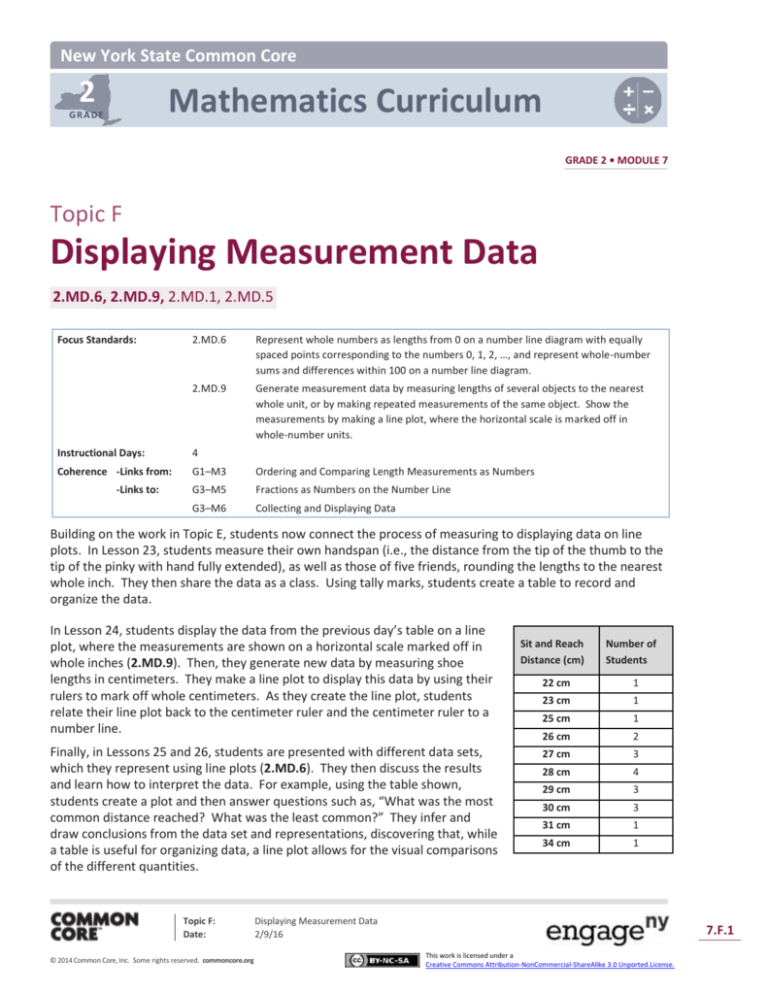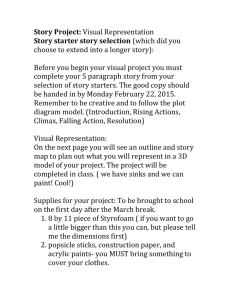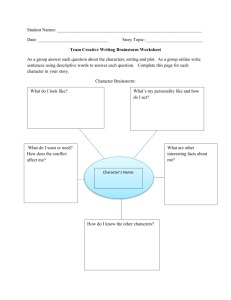
New York State Common Core
2
Mathematics Curriculum
GRADE
GRADE 2 • MODULE 7
Topic F
Displaying Measurement Data
2.MD.6, 2.MD.9, 2.MD.1, 2.MD.5
Focus Standards:
2.MD.6
Represent whole numbers as lengths from 0 on a number line diagram with equally
spaced points corresponding to the numbers 0, 1, 2, …, and represent whole-number
sums and differences within 100 on a number line diagram.
2.MD.9
Generate measurement data by measuring lengths of several objects to the nearest
whole unit, or by making repeated measurements of the same object. Show the
measurements by making a line plot, where the horizontal scale is marked off in
whole-number units.
Instructional Days:
4
Coherence -Links from:
G1–M3
Ordering and Comparing Length Measurements as Numbers
G3–M5
Fractions as Numbers on the Number Line
G3–M6
Collecting and Displaying Data
-Links to:
Building on the work in Topic E, students now connect the process of measuring to displaying data on line
plots. In Lesson 23, students measure their own handspan (i.e., the distance from the tip of the thumb to the
tip of the pinky with hand fully extended), as well as those of five friends, rounding the lengths to the nearest
whole inch. They then share the data as a class. Using tally marks, students create a table to record and
organize the data.
In Lesson 24, students display the data from the previous day’s table on a line
plot, where the measurements are shown on a horizontal scale marked off in
whole inches (2.MD.9). Then, they generate new data by measuring shoe
lengths in centimeters. They make a line plot to display this data by using their
rulers to mark off whole centimeters. As they create the line plot, students
relate their line plot back to the centimeter ruler and the centimeter ruler to a
number line.
Finally, in Lessons 25 and 26, students are presented with different data sets,
which they represent using line plots (2.MD.6). They then discuss the results
and learn how to interpret the data. For example, using the table shown,
students create a plot and then answer questions such as, “What was the most
common distance reached? What was the least common?” They infer and
draw conclusions from the data set and representations, discovering that, while
a table is useful for organizing data, a line plot allows for the visual comparisons
of the different quantities.
Topic F:
Date:
© 2014 Common Core, Inc. Some rights reserved. commoncore.org
Sit and Reach
Distance (cm)
Number of
Students
22 cm
1
23 cm
1
25 cm
1
26 cm
2
27 cm
3
28 cm
4
29 cm
3
30 cm
3
31 cm
1
34 cm
1
Displaying Measurement Data
2/9/16
7.F.1
This work is licensed under a
Creative Commons Attribution-NonCommercial-ShareAlike 3.0 Unported.License.
Topic F 2 7
NYS COMMON CORE MATHEMATICS CURRICULUM
A Teaching Sequence Toward Mastery of Displaying Measurement Data
Objective 1: Collect and record measurement data in a table; answer questions and summarize the data
set.
(Lesson 23)
Objective 2: Draw a line plot to represent the measurement data; relate the measurement scale to the
number line.
(Lesson 24)
Objective 3: Draw a line plot to represent a given data set; answer questions and draw conclusions
based on measurement data.
(Lessons 25–26)
Topic F:
Date:
© 2014 Common Core, Inc. Some rights reserved. commoncore.org
Displaying Measurement Data
2/9/16
7.F.2
This work is licensed under a
Creative Commons Attribution-NonCommercial-ShareAlike 3.0 Unported.License.









